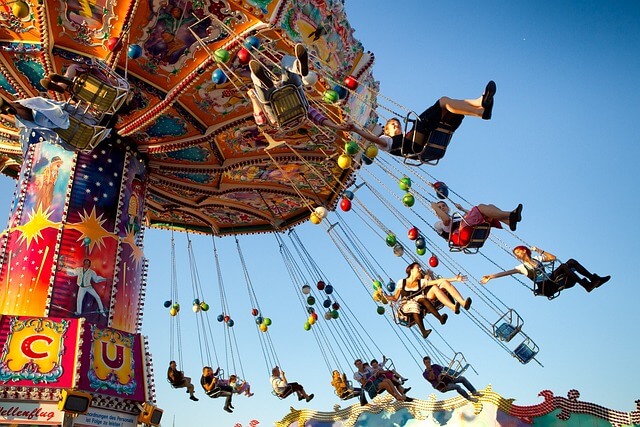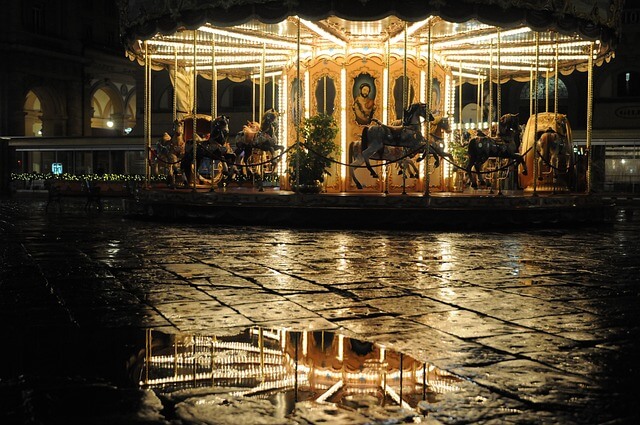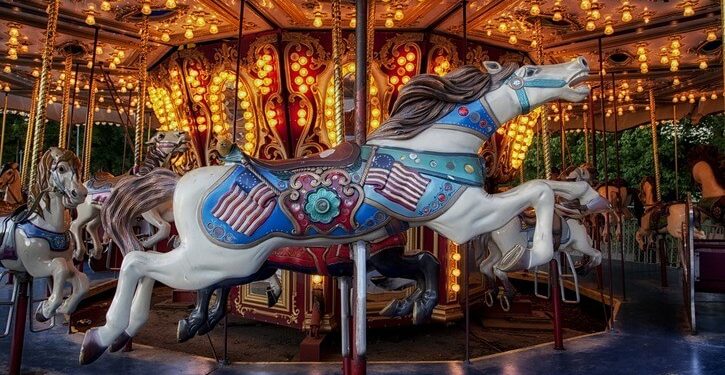Carousels are one of the most popular amusement park rides, attracting both children and adults alike. While they may seem simple, there’s actually a lot of science behind how these rides work and ensure safe experiences for riders. In this blog post, we’ll take a closer look at the science behind carousels and what makes them safe.
How Carousels Work: The Physics of Motion
Carousels are a type of amusement ride that consists of a rotating circular platform with seats for riders. The platform is typically decorated with lights, mirrors, and other decorative elements, and the seats are often shaped like horses or other animals.
The carousel operates using a motor that turns the platform and seats around a central axis. The motor is typically powered by electricity, although some older carousels may use steam or other power sources.
The platform and seats are mounted on a series of gears and bearings that allow them to rotate smoothly and evenly. The horses and other animals are usually attached to poles or other supports that extend from the platform, and they move up and down as the platform rotates.
The riders sit on the horses or other animals and hold onto poles or other supports to maintain their balance as the carousel rotates. The speed of the ride can be adjusted by the operator, and some carousels may also feature music or other special effects to enhance the ride experience.
Overall, carousels are a popular and timeless amusement ride that have delighted generations of riders with their colorful, whimsical designs and thrilling motion.
What is a carousel powered by?
Carousels are typically powered by electric motors that rotate the circular platform on which the seats are mounted. The motor is connected to a gearbox that controls the speed and direction of the rotation.
However, in the past, carousels were powered by a variety of different sources, including steam engines, hand-cranking mechanisms, and even animal power. Steam-powered carousels were popular in the late 19th and early 20th centuries, but they were eventually replaced by electric motors due to their high operating costs and maintenance requirements.
Today, most carousels are powered by electricity, which is a reliable and efficient source of energy. Some modern carousels also incorporate alternative energy sources, such as solar panels or wind turbines, as a way of reducing their environmental impact.
Types of Carousels: Spinning vs. Traditional
Carousels, also known as merry-go-rounds, come in a variety of shapes and sizes, and can be found in amusement parks, fairs, and other public spaces around the world. While all carousels share the same basic concept of riders moving up and down on a rotating platform, there are two main types of carousels: spinning and traditional.

Spinning Carousels
Spinning carousels are characterized by a rotating platform that spins on a vertical axis. Riders sit on individual seats or animals that move up and down as the platform rotates. These types of carousels are often more thrilling and fast-paced than traditional carousels, and are popular with older children and adults.
One popular type of spinning carousel is the “chair-o-plane” or “swing ride”, which features chairs suspended from chains that spin around and around as the ride moves up and down.
Traditional Carousels

Traditional carousels, also known as classic or Victorian carousels, are typically characterized by a stationary platform that does not rotate vertically. Instead, the platform moves in a circular motion, while riders sit on individual seats or on wooden animals that move up and down.
Traditional carousels often feature ornate, hand-carved animals and intricate decorations, and are designed to appeal to younger children and families. Some traditional carousels also feature a band organ or other musical instrument that provides music during the ride.
Overall, both spinning and traditional carousels offer unique and enjoyable ride experiences for riders of all ages. While spinning carousels are often more thrilling and fast-paced, traditional carousels offer a more classic and nostalgic ride experience that is popular with younger children and families.
Ensuring Safe Rides: Safety Features and Regulations
Despite the popularity of carousels, safety is always a top priority for amusement park operators. Carousels have a number of safety features designed to ensure that riders stay safe throughout the ride. These include:
Restraints: Many carousels have lap belts or other types of restraints to keep riders securely in their seats.
Emergency Stop Buttons: Operators have access to emergency stop buttons that can bring the ride to a halt if there is an issue.
Height and Weight Restrictions: To ensure that riders are safe, carousels often have height and weight restrictions to prevent people from riding who are too small or too large to ride safely.
Regular Inspections: Carousels are inspected regularly to ensure that they are in good working order and that all safety features are functioning properly.
In addition to these safety features, carousels are also subject to strict regulations and standards set by government agencies and industry associations. These regulations cover everything from ride design and construction to operational procedures and maintenance requirements.
How are safety restraints or belts used on carousels, and what are their benefits?
Safety restraints or belts are commonly used on carousels to help ensure the safety of riders. These restraints are typically designed to hold riders securely in their seats, preventing them from falling out of the ride or being thrown from their seats during the course of the ride.
On most carousels, the safety restraints are in the form of a lap bar or shoulder harness that is designed to fit across the rider’s lap or shoulders. Some carousels also have seat belts or other forms of restraints that are used in conjunction with the lap bar or shoulder harness.
The benefits of safety restraints on carousels are numerous. First and foremost, they help to prevent injuries and accidents by keeping riders securely in their seats throughout the ride. They can also help to improve the rider experience by providing a greater sense of security and allowing riders to relax and enjoy the ride without fear of falling out.
In addition, safety restraints can be an effective tool for managing rider behavior and preventing inappropriate or dangerous behavior on the ride. For example, if a rider attempts to stand up or otherwise move around on the ride, the lap bar or shoulder harness can help to prevent them from doing so, reducing the risk of injury to themselves or other riders.
Overall, safety restraints are an important component of carousel safety and are essential for ensuring the safe and enjoyable operation of these popular amusement rides.
What steps can riders take to ensure their own safety when riding on a carousel?
While the safety of a carousel ride ultimately depends on the design, operation, and maintenance of the ride itself, there are several steps that riders can take to help ensure their own safety while riding:
Follow all posted safety guidelines: Before getting on a carousel, riders should familiarize themselves with any posted safety guidelines or instructions. This may include information about height restrictions, weight limits, and any specific safety restraints or procedures that must be followed.
Choose an appropriate seat: When selecting a seat on the carousel, riders should choose a seat that is appropriate for their size and physical condition. For example, riders who are particularly tall or large may want to choose a seat with extra leg room or a larger seat.
Secure any loose items: Riders should secure any loose items, such as hats, scarves, or jewelry, before getting on the ride. Loose items can become entangled in the ride’s moving parts or pose a danger to other riders.
Hold on tight: Once on the ride, riders should hold on to any provided safety restraints tightly and keep their hands and arms inside the ride at all times.
Follow ride instructions: During the ride, riders should follow any instructions given by the ride operator and avoid standing up, leaning out, or engaging in any other unsafe behavior.
Speak up if something seems unsafe: If a rider notices anything that seems unsafe or unusual during the ride, they should speak up and inform the ride operator or other park staff immediately.
By following these simple steps, riders can help ensure their own safety and make their carousel ride experience as enjoyable and worry-free as possible.
Conclusion
Carousels may seem like simple rides, but there’s actually a lot of science behind how they work and ensure safe experiences for riders. From the physics of motion to safety features and regulations, operators take great care to ensure that riders can enjoy these classic rides with peace of mind.

